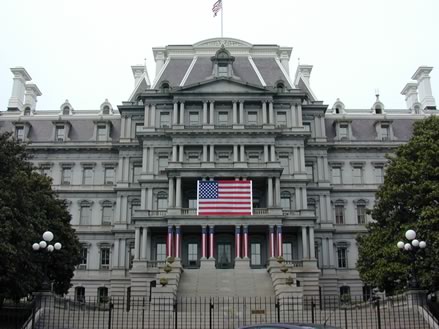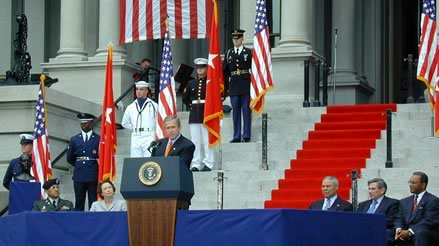

Associate Editor
President George W. Bush, speaking at the formal
renaming and dedication of the Dwight David Eisenhower Executive Office
Building in Washington, D.C., May 7, honored the former general and president
by invoking his spirit of leadership, diplomacy, and humility.
"It seems odd that with all the history it contains, this great building
went more than a century without a name befitting its dignity," the
President remarked standing on the steps that face the West Wing of the
White House. "His name fits this building because he was a great
soldier, a great president, and a good man," Bush said. "Had
he never become president, Eisenhower would still be known to all as the
leader that liberated a continent from a terrible evil."

Designed by Alfred B. Mullett, the supervising architect of the Treasury, the building was commissioned by Ulysses S. Grant and built from 1871 to 1888 to house the growing staffs of the State, War, and Navy departments. It is considered the archetype of French Second Empire architecture in the country.
When completed, the White House Web site notes, it was the largest office building in Washington. It features 4-1/2-inch-thick granite walls, 16-inch-deep ceilings, and nearly two miles of black-and-white marble tile corridors, some with embedded fossils. Almost all of the interior detail is of cast iron or plaster. Monumental curving staircases of granite with more than 4,000 individually cast bronze balusters are capped by four skylight domes and two stained-glass rotundas.
Since its construction, the building has housed some of the nation's most prominent diplomats and politicians. At Tuesday's event, Secretary of State Colin Powell noted that it has housed offices for 16 Navy secretaries, 21 war secretaries, 25 secretaries of State, and 7 men who would later become president. Eisenhower worked in the building as an Army officer, impressing his colleagues and his supervisor, Gen. Douglas MacArthur. The building now serves the various agencies of the Executive Office of the President, including the White House Office, the Office of Management and Budget, and the National Security Council.
General Services Administrator Stephen A. Perry called the building one of the most distinctive in the inventory of the GSA. However, not everyone admired its ornate style. Harry S. Truman, it was noted, called the building the "greatest monstrosity in America." Over time, architects developed plans to replace the large edifice, but costs associated with the project ultimately doomed hopes of changing the look of the building. Eisenhower, who as president saved the building from the wrecking ball, said, "he rather liked it."

President Bush at the dedication ceremony for the Dwight David Eisenhower Executive Office Building. Seated behind him (left to right) are Brig. Gen. David Hicks, chaplain U.S. Army; Susan Eisenhower, granddaughter of the former president; Secretary of State Colin Powell; General Services Administrator Stephen A. Perry; and Deputy Secretary of Defense Paul Wolfowitz.
"Over time, a lot of us have come to like it," Bush said. "The architectural grace of this building will remain a matter of opinion, but its place in history and its place on the skyline of Washington is as safe as can be."
Deputy Secretary of Defense Paul Wolfowitz and Susan Eisenhower, granddaughter of President Eisenhower, also addressed the audience, which included former Secretary of State Henry Kissinger, former Sen. Bob Dole, and current members of Congress, including Sens. Ted Stevens (R-Alaska), who worked in the Eisenhower Administration, and Daniel Inouye (D-Hawaii), who served in World War II.
Congress approved renaming the building for Eisenhower, and President Clinton signed legislation November 1999 and held a ceremony in January 2000. President Bush's ceremony was called a formal dedication and an unveiling of the bust of President Eisenhower.
Copyright 2002 The American Institute of Architects. All rights reserved.
![]()
|
Read more about the history of the Dwight David Eisenhower Executive Office Building. |
|